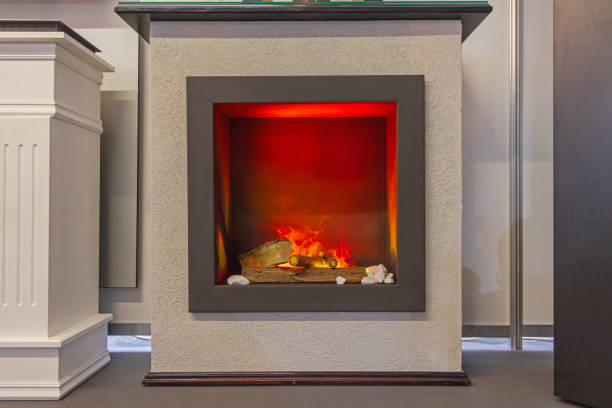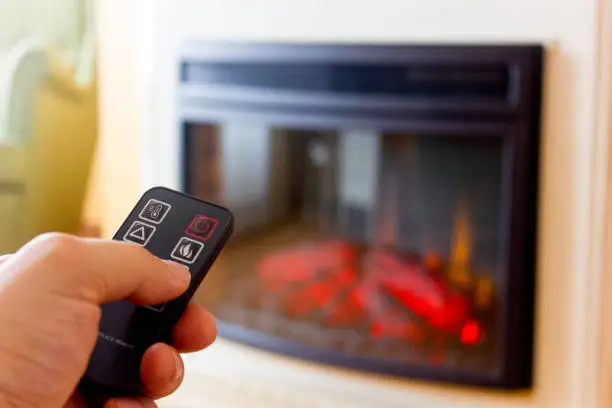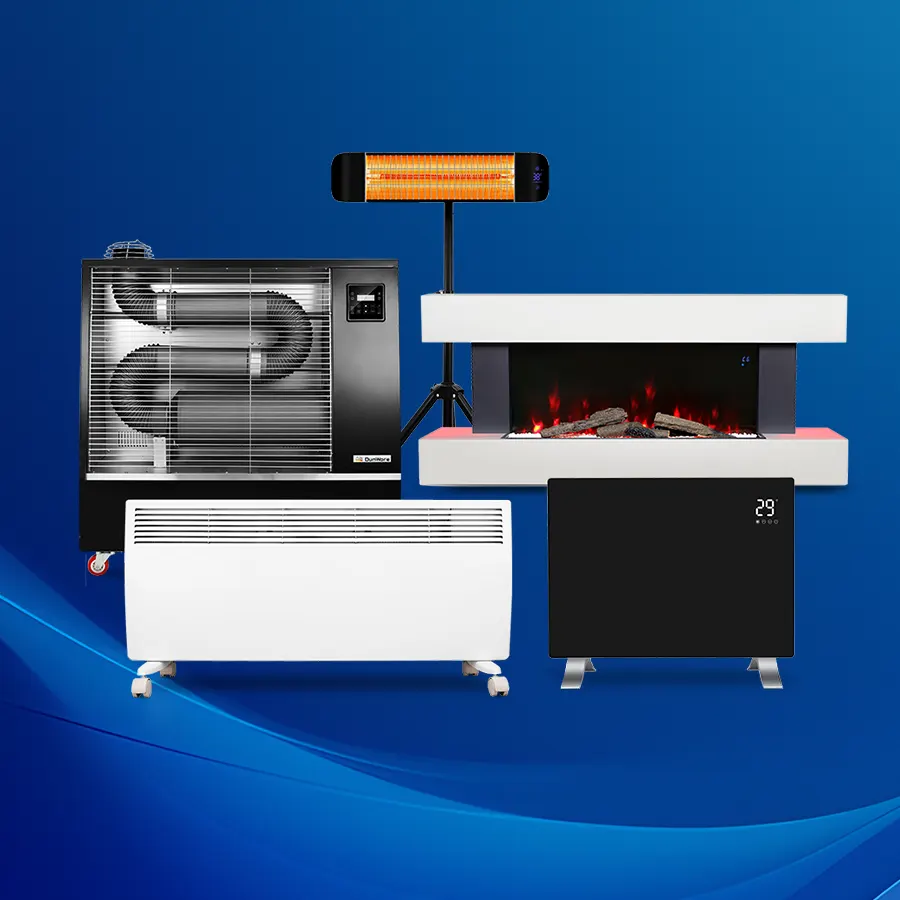Electric fireplaces have become a popular home heating solution, offering a blend of comfort, convenience, and style. Unlike traditional wood-burning or gas fireplaces, electric models provide the warmth and ambiance of a real fire without the hassle of maintenance or the need for venting.
Whether you’re looking to add a cozy touch to your living room, heat a small space efficiently, or simply enjoy the aesthetic appeal of dancing flames, electric fireplaces offer a versatile option for modern living spaces.
Dalam panduan komprehensif ini, we’ll explore everything you need to know about electric fireplaces—from how they work and the different types available, to their benefits, potential drawbacks, and what you should consider before making a purchase.
Whether you’re a first-time buyer or looking to upgrade your existing setup, this article will help you make an informed decision and get the most out of your electric fireplace.
Understanding Electric Fireplaces

What Is an Electric Fireplace?
An electric fireplace is a modern, energy-efficient heating appliance designed to replicate the appearance and ambiance of a traditional wood-burning or gas fireplace. Unlike traditional fireplaces, electric models do not require fuel such as wood or gas and do not produce actual combustion. Instead, these fireplaces use electricity to generate heat, while the visual effect of flames is created using LED lights, often combined with mirrors and other visual technologies.
Electric fireplaces have become increasingly popular among homeowners due to their ease of use, safety, dan efisiensi. They are an ideal choice for those who want the cozy, inviting atmosphere of a fireplace without the hassle of traditional maintenance, such as cleaning chimneys or handling wood. These units are also a great solution for apartments, condos, or spaces where a real fireplace isn’t feasible, allowing people to enjoy the warmth and charm of a fire all year round.
How Do Electric Fireplaces Work?
Electric fireplaces operate using simple yet effective technology. The process begins with the heating element, typically made of metal coils or quartz. When powered on, this element generates heat, warming the air surrounding it. A built-in fan then circulates this heated air throughout the room, providing a comfortable and efficient heating experience.
One of the standout features of electric fireplaces is the realistic flame effect. Instead of actual flames, LED light flames are strategically placed behind a reflective surface (often using mirrors or a special screen) to simulate the appearance of dancing fire. These light-based effects give the illusion of a real fire, adding to the ambiance and charm of the room.
Many modern electric fireplaces offer flexibility in operation, allowing you to use the flame effect independently of the heat. This means that during warmer months, you can enjoy the visual appeal of a fire without generating additional heat, making it a year-round feature for your home.
Components of an Electric Fireplace
- Elemen pemanas
The heating element is the core component of the electric fireplace. It is responsible for generating the heat that warms up the room. This could be a coil or quartz element, both of which are energy-efficient and capable of quickly heating a space. The element is typically powered by electricity and can be easily controlled using a remote or panel.
- Fan
To ensure the heat is distributed evenly across the room, a fan is included in most electric fireplaces. The fan helps circulate the warm air generated by the heating element, allowing it to reach every corner of the space efficiently. This promotes a more even and comfortable heating experience.
- LED Lights
LED lights are the key to creating the flame effect that makes electric fireplaces so appealing. These lights mimic the flickering, glowing nature of a real fire, adding warmth and ambiance to any room. Some units also allow you to adjust the brightness or color of the flames to suit your personal preference, enhancing the visual appeal.
- Controls
Electric fireplaces typically come with user-friendly controls, which may include remote controls, touch panels, or app connectivity. These controls allow you to adjust the heat level, flame effect, and even set a timer for automatic shutoff. Many models also feature adjustable thermostats, allowing you to maintain a comfortable temperature with ease.
Types of Electric Fireplaces

Wall-Mounted Electric Fireplaces
Wall-mounted electric fireplaces are specifically engineered to attach directly to the wall, making them an excellent choice for homeowners who desire a modern, space-efficient heating solution. These units offer a clean, streamlined look and are ideal for urban apartments, small living rooms, or bedrooms where floor space is at a premium. Since they don’t require a chimney or venting system, installation is simple and non-invasive, usually requiring just basic tools and hardware.
Notable Features of Wall-Mounted Fireplaces
- Desain hemat ruang
Perfect for compact areas or minimalist interiors where conserving floor space is essential.
- Contemporary Aesthetic
Features a sleek, flat design with lifelike LED flame effects, often adjustable for brightness and color to match your mood or decor.
- Easy to Install
Most models come with mounting brackets and clear instructions, allowing homeowners to install the unit themselves on drywall, concrete, or brick surfaces.
- Safe and Efficient
As there’s no real flame or combustion, these fireplaces are safe for use around children and pets.
Built-In Electric Fireplaces
Built-in electric fireplaces are designed to be recessed into a wall or cabinetry, offering a fully integrated, custom-finished look that adds value and elegance to any home. These units are best suited for new constructions or major renovations, where long-term planning and design flexibility are possible. Because they are built into the structure, the installation often requires professional assistance, including framing and wiring.
Key Benefits of Built-In Models
- Seamless Integration
Creates a flush, custom appearance that blends effortlessly with walls, entertainment centers, or bookshelves.
- Luxury Appeal
Offers a high-end look, often with larger viewing areas and premium flame visuals that enhance the room’s overall ambiance.
- Long-Term Solution
Ideal for homeowners who are investing in permanent home upgrades or building from scratch.
- Customizable Settings
Many models include advanced features like remote controls, pengatur waktu, thermostats, and flame-only modes for year-round use.
Freestanding Electric Fireplaces
Berdiri bebas perapian listrik offer the charm of a traditional wood stove or fireplace without the need for installation. These plug-and-play units are perfect for renters, seasonal use, or anyone seeking flexibility. Whether placed in the corner of a living room, next to a reading nook, or in a bedroom, freestanding models provide instant heat and visual comfort. Many designs also double as functional furniture pieces, including mantels, media centers, or cabinets.
Advantages of Freestanding Fireplaces
- Portable and Versatile
Can be moved from room to room, making them great for renters or those who enjoy redecorating frequently.
- Instant Warmth and Style
Just plug it into a standard outlet to enjoy the cozy ambiance of realistic flames and gentle heat.
- Multi-Functional
Some models come with built-in shelving, storage compartments, or TV stands, blending form and function.
- No Installation Needed
Requires no mounting, venting, or construction—simply unpack and start enjoying.
Benefits of Electric Fireplaces

Efisiensi Energi
Electric fireplaces are widely recognized for their excellent energy efficiency, especially when compared to traditional heating methods like wood-burning fireplaces or central heating systems. Unlike conventional systems that often suffer from energy loss through ducts, ventilasi, or chimneys, electric fireplaces convert nearly 100% of the electricity they consume into usable heat. This makes them a smart and eco-friendly choice for homeowners looking to reduce their energy usage.
Rather than heating the entire home, electric fireplaces are typically used for zone heating, meaning they warm only the room they are in. This targeted approach helps reduce overall energy consumption, especially during colder months when you may not need to heat every room in the house.
Most electric fireplace models are capable of efficiently heating spaces ranging from 400 ke 1,000 square feet, making them ideal as a supplemental heat source in living rooms, kamar tidur, kantor, or basements.
How Electric Fireplaces Help You Save Energy?
- Zone Heating
Focuses heat where you need it most, reducing energy waste.
- No Heat Loss
Since there are no chimneys, flues, or ducts, all the heat stays in the room.
- Lower Utility Bills
Using an electric fireplace to warm individual rooms helps cut down on your total heating costs.
- Programmable Settings
Many models include timers, thermostats, and energy-saving modes to maximize efficiency.
Considerations Before Purchasing
When choosing an electric fireplace, one of the most critical factors to consider is the size of the room you intend to heat. Electric fireplaces are available in various heating capacities, typically measured in British Thermal Units (BTUs). Selecting a unit with the appropriate BTU rating ensures that the fireplace can efficiently warm your space without overworking or underperforming.
Key Factors to Consider:
- Room Size
Determine the square footage of the room. As a general guideline, you’ll need approximately 10 watts of power per square foot. For example, a 1,000-watt unit can effectively heat a room of around 100 square feet. Larger rooms will require fireplaces with higher BTU outputs to maintain a comfortable temperature.
- Heating Capacity (BTUs)
Electric fireplaces typically range from 4,000 ke 5,000 BTUs for standard models. Some advanced or supplemental heaters can reach up to 9,000–10,000 BTUs. Choose a model that aligns with your room size and insulation level.
- Efisiensi Energi
Look for energy-saving features such as adjustable thermostats, programmable timers, and eco-modes. These features help regulate energy output based on real-time heating needs.
- Placement & Airflow
The effectiveness of your fireplace also depends on where you place it. Avoid placing it in enclosed or obstructed corners that might block airflow. Instead, choose a central, open location to maximize heat distribution.
Fireplace Operation: How to Use an Indoor Electric Fireplace

Proper Setup and Maintenance
To ensure the safe and efficient operation of your indoor electric fireplace, start by choosing an appropriate location. The unit should be placed on a stable, flat surface, such as hardwood, tile, or even carpet or a rug, ensuring that it is not wobbly or at risk of tipping over. Keep the fireplace at least a few feet away from flammable materials, such as curtains, furniture, paper, or bedding.
Always follow the manufacturer’s installation instructions, especially regarding ventilation and clearance space. Regular maintenance is also important. Periodically inspect the vents, intake areas, and around the unit for dust buildup or blockages. Use a soft brush or vacuum to remove debris to prevent overheating and ensure smooth airflow gently.
Turning On and Adjusting Settings
Most electric fireplaces are designed for convenience and come equipped with user-friendly controls. After plugging the unit into a standard wall outlet, you can turn it on using a remote control or the built-in touch panel.
Electric fireplaces typically offer customizable settings to suit your comfort and aesthetic preferences, termasuk:
- Heat Output Levels
Adjust the warmth to your desired level—many models offer low and high heat modes.
- Flame Intensity and Brightness
Choose from subtle ambient lighting to vivid flame effects.
- Flame Color Options
Some units allow you to switch between different flame colors, like orange, blue, or multicolor effects.
- Timer Function
Set the fireplace to run for a specific amount of time, which is ideal for nighttime use or energy savings.
- Kontrol termostat
Advanced models may include digital thermostats to maintain a consistent room temperature.
With proper setup and regular maintenance, your electric fireplace will provide both warmth and ambiance safely and efficiently.
Kesimpulan
Electric fireplaces are more than just stylish additions to modern homes—they’re practical, hemat energi, and safe heating solutions for a wide range of living spaces. With no need for venting, little to no maintenance, and easy installation, they make it possible for anyone to enjoy the ambiance of a traditional fireplace without the challenges of wood or gas alternatives. Whether you’re learning about fireplace operation, wondering how to use an indoor fireplace, or trying to check a fireplace for functionality and safety, this guide has walked you through the essentials.
While electric fireplaces aren’t without their limitations—such as being reliant on electricity and lacking the physical warmth of real flames—their advantages in convenience, design flexibility, and safety make them a smart investment for many homeowners. By understanding your room size, heating needs, design preferences, dan anggaran, you’ll be better equipped to select the model that’s perfect for your space.
From cozy winter evenings to year-round decorative charm, an electric fireplace can elevate the comfort and visual appeal of your home. Use this complete overview as your go-to reference when choosing, installing, and maintaining your unit—and enjoy the warmth and peace of mind it brings.
FAQ
Is it okay to leave an electric fireplace plugged in all the time?
Electric fireplaces have built-in safety features in the areas that heat the most, such as thermostats that automatically shut off the power when a certain temperature is reached. It’s generally safe to leave them unattended.
Which brand of electric fireplace is the best?
Yika’s electric fireplaces, a harmonious blend of traditional and contemporary designs, catering to both classic & contemporary electric fireplaces. Yika specializes in providing wholesale options, Kolaborasi OEM, and extensive customization services.
How much does it cost to run an electric fireplace all day?
An electric fireplace typically costs about $0.18 per hour to run. Using energy-efficient settings and timers helps control electricity expenses.
Are electric fireplaces safe on carpet?
Ya, it is safe to place an electric fireplace on carpet or a rug. Electric fireplaces can be safely installed on any stable and level surface.
Do electric fireplaces need to be vented?
TIDAK, electric fireplaces do not require any venting or chimneys. Unlike traditional wood-burning or gas fireplaces, electric fireplaces do not produce real flames, smoke, or harmful byproducts such as carbon monoxide. This means they can be safely installed in virtually any room without the need for a flue or external ventilation system.





















